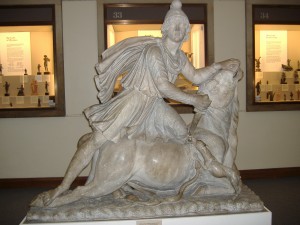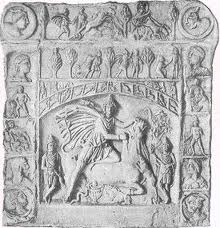Click here for direct link to audio Episode #15.
Click here for previous episodes.
Surely you’ve seen the statues. The Tauroctony. This one is from the British Museum. A good-looking guy with longish hair, wearing a short tunic, a flowing cape, and a Phrygian cap. He looks nice enough, but he’s plunging a dagger into the neck of a bull that appears to have been minding his own business! My word! What’s up with that? And then you’ve got this little dog and the scorpion and the crab and the snake all hanging out with the bull. Who can figure that out?
Well, as archaeology is a fairly young discipline, we’ve got some catching up to do. The deets about Mithraism are still being catalogued by our brothers & sisters “in the fieldâ€. To get a sense of the vastness of Mithraic worship, there are at least 190 known Mithraea around the Roman world and a mere 1/10th of them have been excavated. Fifteen Mithraea have been located beneath Catholic churches in Rome.
But there’s a lot that we may never know or understand, no matter how long or hard archaeologists work. A true “mystery religionâ€, believers were bound to secrecy on pain of death, so no written evidence exists at this time to describe their rituals and practices. One Mithraic practice we are certain of is that on occasion a real bull was slaughtered above the vaulted underground temple site and the blood of the animal showered down over a select individual. Egads! Let me outta here!  
We also know that it was primarily a religion of the Roman military. Over the centuries, Mithraism worked its way up from the lower classes into the Roman elite. Mithraism took hold in Imperial Rome around the 2nd century CE after the Emperor Commodus was initiated into its mysteries. Freed slaves achieved wealth and status, and veterans of the military retired to Rome itself or some province of the empire and lived out their days practicing their religion. Ultimately, pagan religions were outlawed by Theodosius at the end of the 5th century and Mithraism died out.
Enjoy today’s episode. Next week I detail some of the recent theories on the astronomy behind Mithraism.
Homework for this week: read an encyclopedic entry for astronomy to get the basic concepts down before next week’s episode.
